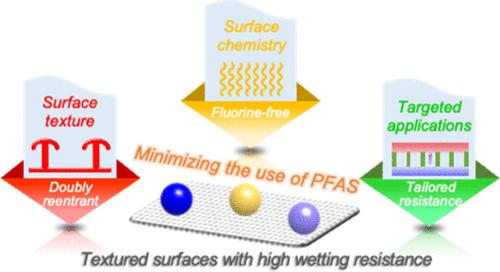尽量减少使用全氟烷基和多氟烷基物质的织构抗湿表面
IF 11.3
1区 环境科学与生态学
Q1 ENGINEERING, ENVIRONMENTAL
引用次数: 0
摘要
全氟烷基和多氟烷基物质(PFAS)已被用作合成化学品,用于制造具有纹理的耐湿表面,其应用范围广泛,包括全疏膜,自清洁纺织品和防腐涂层。然而,PFAS的高持久性、毒性和生物蓄积性已经引起了公众的关注和严格的法规,特别是在美国环境保护署(USEPA)于2024年4月宣布六种PFAS物种的法律强制最高污染水平之后。在本文中,我们提出了我们的观点,即在制造织构的全疏和超疏表面中可以避免使用PFAS,这些表面不仅对高表面张力液体而且更重要的是对低表面张力液体具有高的抗润湿性。我们首先讨论了PFAS在常规抗湿表面设计中的作用。然后,我们讨论了创造具有高耐湿性的无pfas纹理全憎和超憎表面的最新策略,同时阐明了潜在的机制。此外,我们强调,在海水淡化和废水处理等特定环境应用中,具有足够高耐湿性的纹理表面确实并不总是需要PFAS。我们设想这篇论文将激励科学界重新思考和革新设计框架,朝着更可持续的抗湿表面发展,从而避免PFAS的使用以及随之而来的健康和环境风险。本文章由计算机程序翻译,如有差异,请以英文原文为准。

Minimizing the Use of Per- and Polyfluoroalkyl Substances for Textured Wetting-Resistant Surfaces
Per- and polyfluoroalkyl substances (PFAS) have been used as synthetic chemicals to create textured wetting-resistant surfaces, which have a broad range of applications including omniphobic membranes, self-cleaning textiles, and anticorrosion coatings. However, the high persistence, toxicity, and bioaccumulation potential of PFAS have led to rising public concerns and stringent regulations, especially after the U.S. Environmental Protection Agency (USEPA) announced legally enforceable maximum contamination levels for six PFAS species in April 2024. In this paper, we provide our perspective that the use of PFAS can be avoided in the fabrication of textured omniphobic and superomniphobic surfaces, which display high wetting resistance against not only high surface tension liquids but also more importantly low surface tension liquids. We first discuss the role of PFAS in the design of conventional wetting-resistant surfaces. We then discuss the state-of-the-art strategies for creating PFAS-free textured omniphobic and superomniphobic surfaces with high wetting resistance while elucidating the underlying mechanism. Further, we emphasize that PFAS are indeed not always needed for textured surfaces with a sufficiently high wetting resistance in specific environmental applications such as desalination and wastewater treatment. We envision that this paper will motivate the scientific community to rethink and revolutionize the design framework toward more sustainable wetting-resistant surfaces, thereby circumventing the use of PFAS and the consequent health and environmental risks.
求助全文
通过发布文献求助,成功后即可免费获取论文全文。
去求助
来源期刊

环境科学与技术
环境科学-工程:环境
CiteScore
17.50
自引率
9.60%
发文量
12359
审稿时长
2.8 months
期刊介绍:
Environmental Science & Technology (ES&T) is a co-sponsored academic and technical magazine by the Hubei Provincial Environmental Protection Bureau and the Hubei Provincial Academy of Environmental Sciences.
Environmental Science & Technology (ES&T) holds the status of Chinese core journals, scientific papers source journals of China, Chinese Science Citation Database source journals, and Chinese Academic Journal Comprehensive Evaluation Database source journals. This publication focuses on the academic field of environmental protection, featuring articles related to environmental protection and technical advancements.
 求助内容:
求助内容: 应助结果提醒方式:
应助结果提醒方式:


